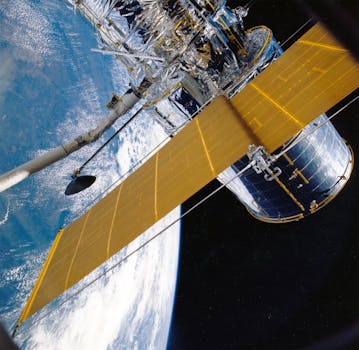GEO Satellites: Understanding the Technology and Its Applications
GEO satellites, or Geostationary Earth Orbit satellites, are a type of satellite that orbits the Earth at an altitude of approximately 36,000 kilometers. At this height, they remain stationary relative to a fixed point on the Earth’s surface, allowing them to provide continuous coverage of a specific region. GEO satellites are a crucial part of modern telecommunications, providing global coverage and enabling a wide range of applications, including television broadcasting, telecommunications, and weather forecasting.
The technology behind GEO satellites is complex and fascinating. These satellites are equipped with transponders, which are devices that receive and re-transmit signals. The signals are transmitted from the Earth’s surface to the satellite, where they are amplified and re-transmitted back to the Earth. This process allows for the transmission of data, voice, and video signals over long distances, making it possible to communicate with people and devices all over the world.
The Benefits of GEO Satellites
GEO satellites have numerous benefits, including global coverage, high bandwidth, and reliability. They provide a wide range of services, including television broadcasting, telecommunications, and internet connectivity. GEO satellites are also used for weather forecasting, navigation, and remote sensing. Additionally, they play a critical role in disaster response and recovery, providing emergency communications and supporting search and rescue operations.
One of the significant advantages of GEO satellites is their ability to provide global coverage. They can transmit signals to any point on the Earth’s surface, making it possible to communicate with people and devices in remote or hard-to-reach areas. This is particularly important for areas where traditional communication infrastructure is limited or non-existent. GEO satellites can also provide high-bandwidth services, making them ideal for applications that require large amounts of data to be transmitted, such as video streaming and online gaming.
Applications of GEO Satellites
GEO satellites have a wide range of applications, including television broadcasting, telecommunications, and weather forecasting. They are used to transmit television channels, providing entertainment and news to people all over the world. GEO satellites are also used for telecommunications, enabling people to make phone calls, send texts, and access the internet. Additionally, they are used for weather forecasting, providing critical information about weather patterns and storms.
GEO satellites are also used for navigation, providing location information and supporting navigation systems such as GPS. They are used for remote sensing, providing data about the Earth’s surface and atmosphere. This information is used for a wide range of applications, including climate monitoring, agriculture, and natural resource management. Furthermore, GEO satellites play a critical role in disaster response and recovery, providing emergency communications and supporting search and rescue operations.
The Future of GEO Satellites
The future of GEO satellites is exciting and rapidly evolving. Advances in technology are enabling the development of new and more powerful satellites, with higher bandwidth and greater capabilities. The increasing demand for satellite services is driving innovation, with new applications and services being developed all the time. Additionally, the launch of new satellite constellations is expanding the reach and capabilities of GEO satellites, providing greater coverage and more services to people all over the world.
However, the future of GEO satellites is not without challenges. The increasing amount of space debris in Earth’s orbit is a significant concern, as it can damage or destroy satellites. Additionally, the regulatory environment is becoming more complex, with new rules and regulations being introduced to manage the use of satellite technology. Despite these challenges, the benefits and potential of GEO satellites make them an essential part of modern telecommunications and a critical component of our global infrastructure.
